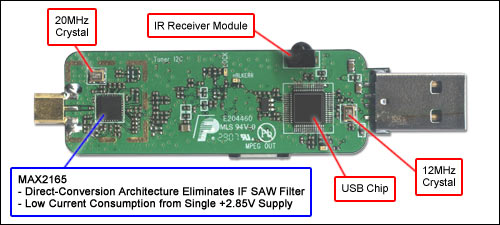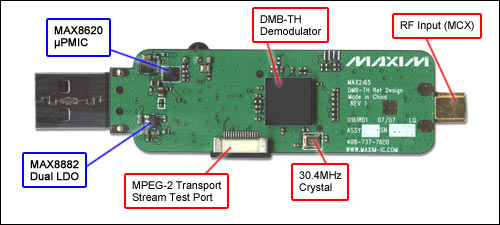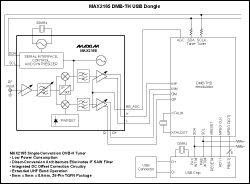MAX2165 DMB-TH USB Dongle Reference Design

Click here for an overview of the wireless components used in a typical radio transceiver.


Figure 1. The reference design for the compact DMB-TH USB dongle features the MAX2165.

More detailed image (PDF, 232kB)
Figure 2. System block diagram.
详情介绍

Click here for an overview of the wireless components used in a typical radio transceiver.


Figure 1. The reference design for the compact DMB-TH USB dongle features the MAX2165.

More detailed image (PDF, 232kB)
Figure 2. System block diagram.
Lab Measurements
MAX2165 Noise Figure and Maximum Gain

Figure 3. The noise figure ranges from 3.0dB to 4.3dB, with maximum gain ranging from 79.2dB to 81.8dB over 474MHz to 858MHz.
MAX2165 Phase Noise at 474MHz

Figure 4. Phase noise at 1.0kHz offset is -99dBc/Hz when the LO frequency is 474MHz.
RF Input Return Loss

Figure 5. The input return loss is better than -7.7dB from 474MHZ to 858MHz when the LO frequency is 858MHz.
Detailed Description
This DMB-TH receiver reference design includes the MAX2165 direct-conversion tuner, a DMB-TH demodulator, and USB interface circuitry. This solution is intended for handheld or laptop computer-based digital video broadcast applications in the Chinese market. The design covers the 470MHz to 858MHz UHF band.
The MAX2165 direct-conversion architecture eliminates the need for an IF-SAW filter. Programmable baseband channel-selection filters allow for operation with 7MHz and 8MHz channels. The fractional-N synthesizer reduces VCO lock time and minimizes close-in phase noise, thus eliminating the need for power-hungry, phase-noise reduction algorithms.
The DMB-TH demodulator accepts I/Q inputs from the tuner and supplies a MPEG-2 transport stream to the USB chip. The USB chip enables interfacing with a laptop or desktop computer for viewing broadcast video and for lab analysis.
